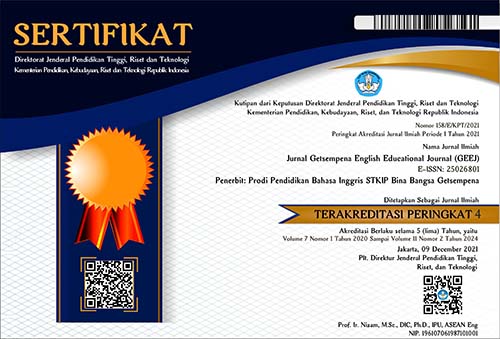UTTERANCES IN THE WOMAN IN THE WINDOW MOVIE AN ANALYSIS OF ILLOCUTIONARY ACT
Abstract
This research aims to identify the illocutionary act performed by the main character in The Woman in the Window movie. This movie tells the story of Anna Fox, the main character with agoraphobia. The researchers are interested to find out the types of illocutionary act in the utterances of a person suffering from an anxiety disorder. Qualitative research and content analysis are used as the methodology. The data are collected from the movie and analyzed through some steps. The theory of Searle (1976) is applied to analyze the data. The findings reveal that four types of illocutionary act:18 assertives, 6 directives, 1 commisives, and 5 expressives utterances are used by the main character in attempting to investigate a murder. The purposes of the illocutionary act are to conclude, to state as assertive utterances, to ask, to request, to order, to command, to beg as directives utterances, to make a duty to herself as commisives utterances, and to apologize, to dislike, to thank as expressive utterances. The dominant utterance used was assertives which carries the value of true or false. It indicates that the main character was trying hard to convince the police officer of what she said was true. Interestingly, only 1 commissive utterance was used to prove what she saw was true. It explains the condition of the main character with agoraphobia.
References
Asmundson, G. J. G., Taylor, S., & Smits, J. A. J. (2014). Panic disorder and agoraphobia: An overview and commentary on DSM-5 changes. Depression and Anxiety, 31(6), 480–486.
Austin, J. L. (1962). How to Do Things with Words. Oxford University Press.
Creswell, J. (2014). Research Design: Qualitative, Quantitative, and Mixed Methods Approaches (Fourth). SAGA Publication, Inc.
Hastuti, E., Utami, H. A., & Oswari, T. (2021). Illocutionary Acts Uttered By the Main Character in Fear of Rain Movie: Pragmatic Approach. Jurnal Basis, 8(2), 153–164. https://doi.org/10.33884/basisupb.v8i2.4441
Hidayat, A. (2016). Speech Acts: Force Behind Words. English Education, 9(1), 1–12.
Huang, Y. (2017). Pragmatics (First). Oxford University Press.
Indrawati, N. L. S., Ariyaningsih, N. N. D., & Candra, K. D. P. (2021). An Analysis of Assertive Illocutionary Acts Used by Local Guides in Tirta Empul Temple. Journal of Humanities, Social Science, Public Administration and Management (HUSOCPUMENT), 1(3), 126–130. https://doi.org/10.51715/husocpument.v1i3.35
Lestari, S. A. S. (2020). Illocutionary Acts of Depressed Teenagers as Used in WhatsApp ( Pragmatic Analysis ). Hasanuddin University.
Levinson, S. C. (1983). Stephen C Levinson - Pragmatics- Cambridge Textbooks in Linguistics.pdf (First). Cambridge University Press.
Mey, J. L. (2001). Pragmatics: An Introduction (Second). Willey-Blackwell.
Nadeak, M. F., Sunggingwati, D., & Valiantien, N. M. (2017). An Analysis of Illocutionary Act and Perlocutionary Act of Judy Hopps'Utterances in Zootopia Movie (2016). Jurnal Ilmu Budaya, 1(4), 305–316.
Rahayu, F. N., Arifin, M. B., & Ariani, S. (2018). Illocutionary Act in the Main Characters' Utterances in Mirror Mirror Movie. Jurnal Ilmu Budaya, 2(2), 175–187.
Searle, J. R. (1976). A Classification of Illocutionary Acts (pp. 5(01), 1–23).
Yule, G. (2010). The Study of Language (Fourth). Cambridge University Press.
























